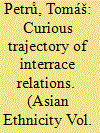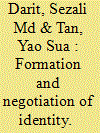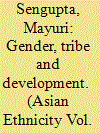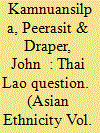|
|
|
Sort Order |
|
|
|
Items / Page
|
|
|
|
|
|
|
| Srl | Item |
| 1 |
ID:
157950


|
|
|
|
|
| Summary/Abstract |
This article aims to examine several interrelated issues pertaining to the historical development of pluralism in areas forming today´s Malaysia. Firstly, it intends to analyze the transformation of the formerly cosmopolitan populations of Malay port polities into the highly ‘racialized’ society of modern Malaysia. It also seeks to clarify the roots of ethnicity-based issues and relations in the country. Lastly, it attempts to challenge the very concept of Malaysia as a society primarily consisting of three ethnic pillars, dominated by the Malays, and ‘complemented’ by the Chinese and the Indians. I argue that the main driving force behind these tensions is the segregational colonial policies and the postcolonial arrangements of the Malay ethnocentrist governments, rather than ethnic and cultural factors as the ruling politicians tend to stress. I also contend that religious issues, especially those stemming from the dakwah movement, are gradually becoming an increasingly important factor in interrace strife.
|
|
|
|
|
|
|
|
|
|
|
|
|
|
|
|
| 2 |
ID:
157949


|
|
|
|
|
| Summary/Abstract |
This study attempts to provide a portrayal of emotional intelligence (EI) of the Indonesians, one of the fourth most populous countries and multiethnic societies in the world, specifically across the 404 Bataks, 430 Minangkabau, and 479 Javanese ethnics. The result indicated that the Indonesian version of the EQ-i is invariant across the three ethnic groups. The findings also showed that the three ethnic groups have some shared characteristics in terms of interpersonal, assertiveness, empathy, social responsibility, flexibility, and problem-solving competences. We found significant main effects of ethnicity and gender as well as the interaction effect on EI competences. Cross-ethnic comparison showed that the Minangkabau assessed in this study are the most underdeveloped group in terms of social and emotional capabilities. We recommend replications of this study for other Indonesian ethnic groups to draw a more valid conclusion and to support the development of society.
|
|
|
|
|
|
|
|
|
|
|
|
|
|
|
|
| 3 |
ID:
157948


|
|
|
|
|
| Summary/Abstract |
This article examines the formation and negotiation of identity among the Kampung Pasir Parit Peranakan Chinese, a unique sub-ethnic group of acculturated Chinese in Kelantan. Apart from their original Chinese identity, the Kampung Pasir Parit Peranakan Chinese have also adopted two additional identities, namely Malay and Siamese identities. Intermarriage with Siamese women in the early years is the main reason for the adoption of the Siamese identity, while regular social interactions with the local Malays have led to the adoption of a Malay identity. Thus, the identity of the Kampung Pasir Parit Peranakan Chinese comprises three contrasting components. Given such a complex identity, there is always a need for the Kampung Pasir Parit Peranakan Chinese to negotiate their identities to avoid any identity crisis. This negotiation of identity is at times demonstrated by the co-existence of identities and at times the clear demarcation of identities to fulfil different situational needs.
|
|
|
|
|
|
|
|
|
|
|
|
|
|
|
|
| 4 |
ID:
157952


|
|
|
|
|
| Summary/Abstract |
The article critically examines the gendered impacts of state-led development among the Reang tribal community in Tripura (Northeast India) and outlines causes of gender-based inequalities that affect Reang women’s ability to engage in livelihood, achieve financial independence and participate in political affairs of the state. The article outlines two interlinked arguments. First, gender-based inequalities are not adequately addressed by the postcolonial Indian state which tends to homogenise members of tribal communities through development policies by privileging ethnicity over gender. Second, gender-based inequalities are also not adequately addressed within the Reang community highlighting complex intra-tribal dynamics wherein differential notion of inequalities among the Reangs and position of certain influential actors within the community determines which issues are addressed and which are marginalised.
|
|
|
|
|
|
|
|
|
|
|
|
|
|
|
|
| 5 |
ID:
157947


|
|
|
|
|
| Summary/Abstract |
This article applies Henri Lefebvre’s concept of rhythmanalysis to an exploration of ethnicity in Hong Kong. It argues that rhythmanalysis has tended to be used in social geography, architectural research, and cultural studies and has been overlooked as a methodological tool in regard to ethnicity. An historic narrative of ethnic diversity in Hong Kong is contrasted with contemporary transformations. It is argued that rhythmanalysis presents an alternative perspective that can deepen knowledge about enduring social patterns that serve to contextualise ethnicity and ethnic relations in a given space. In conclusion, it is argued that there is a need for greater recognition of ethnic diversity in Hong Kong as a means to assert a more confident and secure local identity.
|
|
|
|
|
|
|
|
|
|
|
|
|
|
|
|
| 6 |
ID:
157951


|
|
|
|
|
| Summary/Abstract |
This article presents an anatomy of the 2011 Thailand Country Report to the Committee responsible for the UN Convention for the Elimination of All Forms of Racial Discrimination, in which Thailand recognized its largest ethnic minority community, the Thai Lao, to the international community. The article analyses the Country Report as well as the deliberations of the Committee in dialogue with the Thailand Country Delegation. It provides a policy context for the Country Report, including Thailand’s classification of ethnic communities. The article argues the need to minimize racialized discrimination as regards the Thai Lao. Five policy issues, framed in the context of inclusion and which arise from the recognition of the Thai Lao by the Country Report, are considered. The article concludes by discussing how the Thai Lao may be better included in Thailand via political developments towards a social democracy in Thailand, for social democracy can recognize sociocultural rights.
|
|
|
|
|
|
|
|
|
|
|
|
|
|
|
|
|
|
|
|
|